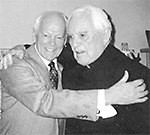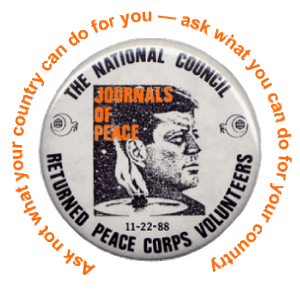The Journals of Peace Capital Rotunda, November 21, 1988
The Journals of Peace
Making It Happen
by Tim Carroll (Nigeria 1963–66)
•
In 1988, as the first Director of the National Council of Returned Peace Corps Volunteers (NCRPCV), now the National Peace Corps Association, I felt a considerable part of my mandate was to bring our disparate numbers together, to gather us up to celebrate those feelings we had in common. A number of special events given under my tenure accomplished this in varying degrees of success, but none held the hearts of Peace Corps family as did the Journals of Peace.
As the 25th anniversary of the death of President John Kennedy — the founder and much loved hero of early Volunteers — approached, I made a call to St. Matthew’s Cathedral, the church that had been the site of JFK’s funeral service, and asked if we might have a memorial Mass that would include not only the traditional Showing of the Colors, but a procession of flags, carried by returned Volunteers, representing all their countries of service. The priests quickly agreed.
Then in a conversation with John Coyne (Ethiopia 1962–64), he mentioned how many PCVs had kept journals while overseas and suggested we might have RPCVs read from their journals for twenty-four hours before the memorial Mass at the Cathedral.
When this proved to be impossible at St. Matthews, I called Connecticut Senator Chris Dodd (Dominican Republic 1966–68)) and asked if it might be possible to stage such a vigil in the Capital Rotunda. Holding a 24-hour vigil in the Rotunda of the U.S Capitol had never happened before,(at that time the Capitol Rotunda was open to the public from 9:00 am to 4:30 pm) but the good Senator made it happened.
RPCVs respond to the invitation
Next, we put out a call to RPCVs around the world and asked them to come to Washington, D.C. on November 21, 1988, and remember John F. Kennedy and their service for America in the Peace Corps by reading from their journals. So began the Journals of Peace.
The response from the RPCV community was overwhelming and was almost more than the nascent staff at the NCRCV could handle. That staff included Kitty Thuermer (Mali 1977–79), Jeff Drumtra (Niger 1978–80), Mark Hallett (Philippines 1983–85), Laura Byergo, (PC/Staff Burndi), Geoffrey Greenwell (Zaire 1986–87), and Michael McGirr (Sierra Leone 1977-80) who was the Journals of Peace Director. Many others donated their time, including Dennis Grubb (Colombia 1961–63), who handled the press for the event.
Returned Volunteers from across the nation, hearing about the opportunity of reading a minute or two from their journals, signed up in the hundreds and quickly filled the 24-hour time slots with their three-minute readings.
The Journals of Peace
From mid-afternoon on November 21, 1988, until it was time for the Mass to begin the following day, Volunteers of all sizes, shapes, and ages read inspiringly from their journals, or retrieved from their memories, fragments for what had been for them the defining moments of their young lives. Through the night it continued each story, each anecdote another piece of the message: when you are working for others your own life is enlarged, enhanced and made memorable.
We gave the final time slot to then-Director of the Peace Corps, Loret Miller Ruppe, who, while not a Returned Volunteer, had in her eight year’s as head of the agency, come to reflect the attributes Volunteers respected, among them that peace was more important than politics.
A service of remembrance
When Loret finished her presentation, there was a seamless transition to the cathedral. There the first Director of the Peace Corps, Sargent Shriver; his deputy, Bill Moyers; and Father Theodore Hesburgh, a former Peace Corps adviser and president emeritus of President of Notre Dame, were among the officials presiding over the service.
Over 1,500 attended this service of remembrance at St. Matthew’s where Father Hesburgh, would remark in his homily, “I think if Kennedy were standing here today, his hair probably white like mine, he would say, ‘You are the people that took the best message that I gave to the world. You understood what it meant to serve.’”
Bill Moyers recalled the 1960s in his tribute to Kennedy. “I hear the sounds of crowds cheering and cities burning, of laughing children and weeping widows, of nightriders, nightmares and napalm, of falling barriers and new beginnings and animosities as old as Cain and Abel . . . . But something survived those years which bullets could not stop. An idea survived, embodied in the Peace Corps . . . Out there, John F. Kennedy might say, is the new frontier.”
A handful of RPCVs — Peggy Anderson (Togo 1962–64), John Coyne (Ethiopia 1962–64), Paul Tsongas (Ethiopia 1962–64) and Roger Landrum (Nigeria 1961–63) — were asked to say a few words in the Cathedral which acted as a Coda to the Journals of Peace.
Following the service of remembrance, Peace Corps Director Ruppe hosted a reception for all the participants at the Peace Corps Headquarters, which was then located at 1990 K Street.

Tim (L) with the late Father Theodore M. Hesburgh, former president of Notre Dame University and his longtime friend and mentor
Tim Carroll has had a long history of service. Following his Peace Corps tour in Nigeria, he created and directed for a decade Eye Care, Inc., in Haiti. For this, he received in 1986 the first Shriver Award for Humanitarian Service. He then took over the new RPCV group as it director before becoming a Peace Corps CD in Pakistan, Poland, and Russia between 1990 and 1995. Leaving the Peace Corps, he founded the Office of Protocol for the Department of Justice, (1997-01) and then retired from government service. In 2001 he sold his home in Washington, D.C., and moved to his family farm located on the shores of Lake Michigan. He continues his interest in international affairs, however, and travels often and widely.

Thank you so much, John. What a beautiful memory. I am in tears with the power of it.
Participating in the Journals for Peace by reading our selections, listening to other RPCV’s reading theirs, was a moving experience made more so by the event taking place in the rotunda of the Capital building. I suspect that many of us, Jackie and myself included, had never even been in the Capital rotunda. Many of us who read our pieces had names as well.
Thank you so much for writing this up. Participating in this event is one of my favorite Peace Corps memories, and I kept the article about this that appeared in USA Today as well as the write-up in WorldView Magazine. Would it be possible to get these two documents online?
I met my future wife (Paula Hirschoff) at this event. I was PC Nepal (68-70) and she Kenya (68-70). We both had amazing PC experiences. We were both reading in the Rotunda. Then at Paula’s suggestion, we rejoined to serve in Senegal (05-07) and then led the PC reform movement from 07-15. We flew in from Senegal to testify before the Senate Foreign Relations Committee on the Dodd PCV Empowerment Act, which I had written. I’d been a Senate staffer for decades and worked with Dodd’s staff to write it. We loved our second time service and are proud of our championing PC reform, then much needed. Thanks.